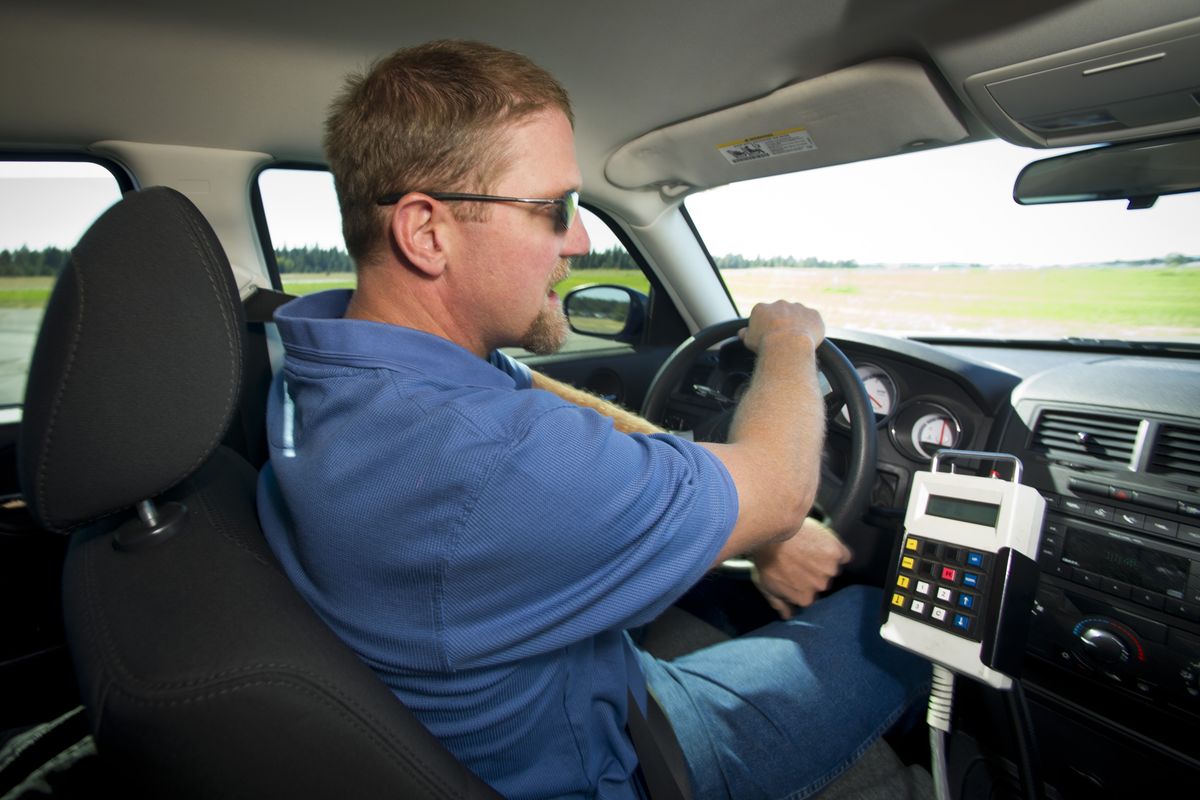County’s SkidCar program teaches icy-road techniques

Spokane County’s Risk Management Department brings December to the Deer Park Airport all summer long.
That’s where the department uses a spider-like “SkidCar” on an unused runway to teach employees how to drive on slick roads while the pavement is still dry.
“It’s just like you’re driving on ice,” said Dean Grewe, a truck driver and equipment operator in the county Road Department.
A 2008 Dodge Charger rides on a frame with four outriggers that resemble bicycle training wheels. At the push of a button, the outriggers lift the car off the pavement just enough to make it skid.
Hydraulic pistons selectively push down on the training wheels to make the real wheels lose traction. The smooth outrigger tires have little traction, so they skid along with the regular tires.
The training device, manufactured by SkidCar System, is one of about a half-dozen in Washington and 270 in the nation. It allows drivers to experience real skids instead of computer simulations.
A SkidCar system costs about $55,000, but Spokane County got its unit free from the Washington Association of Counties Risk Pool when the organization got out of the training business several years ago.
“Auto liability is a big one in a county, especially when you’re self-insured,” said Cliff Berg, one of three risk management specialists who are certified SkidCar instructors.
Spokane County’s self-insurance program covers 800 employees who drive 790 vehicles on 2,500 miles of public roadway.
Berg and his colleagues, John Foster and Cindy Close, suspend the usual “prime directive” of winter driving: Slow down.
“We push people until they panic, because that’s when we do crazy things,” Berg said.
Thanks to the training wheels, students don’t have to go very fast to lose control. A speed of 20 mph does the trick.
If instructors start to share a student’s panic, there’s an emergency shutoff.
“I haven’t had to hit the panic button too much,” but there have been a few occasions, Berg said.
With the proper degree of panic, students learn what to do in a skid or, more often, what not to do.
Bad-weather crashes inevitably involve “too much of something,” Foster said. Too much steering or too much braking, as well as too much speed, can send a vehicle into a ditch or oncoming traffic.
Training sessions begin with too much of a lot of things. Students are encouraged to demonstrate their ordinary practices while instructors take notes.
Clumsy hand-over-hand steering is a common problem. The criss-cross technique reduces control and increases the likelihood of broken wrists if the steering-wheel airbag is activated.
Grewe said he was dubbed “Mr. Cautious for the day” during a recent class.
But another Road Department driver, Gloria Vail, said she “was just going for the gusto the first time around.”
She said Foster told her, “Man, oh, man, do we have some things to work on, Gloria.”
Vail’s passenger and co-worker, Kraig Wise, was in danger of losing his breakfast. He, in turn, demonstrated what he called “all of my MacGyver moves.”
Wise and other snowplow drivers have a few bad-weather tricks, such as using their plow blades as an anchor, but nothing that rewrites the laws of physics.
“At any moment, you can lose traction,” Vail said. “We’re not exempt. Believe me, it’s not a good feeling when that road drops out from under you.”
Even road graders can lose traction, Vail said.
The SkidCar provides a good simulation for workers who routinely go to the slickest spots in the county, truck driver Harold Carlson said. He appreciated advice about not overcorrecting or overbraking during a skid.
Instructors emphasize “long braking” instead of the last-second “stab,” and suggest “shuffle steering” – a sort of back-and-forth motion that resembles the way actors drive in old movies.
Truck driver Scott Lynch was impressed by a tip about looking in the direction he wants to go, not where his vehicle is going during a skid.
“If you’re looking where the car is going, most of the time you’ll end up in the ditch,” he said. “You’d think that wouldn’t make any difference.”
The difference that interests county Risk Manager Steve Bartel is in accident rates.
It’s impossible to say how many crashes are prevented by SkidCar and other training programs, but Bartel said claims against the county have been coming down since adoption of a vehicle-use policy in 2008.
There were 27 claims in 2008, which was a bad snow year, 19 in 2009 and 10 in 2010.
The vehicle policy requires all employees who drive on county business to receive training every three years. Options include SkidCar classes, a defensive driving course or emergency vehicle training for law enforcement officers.
Sheriff’s Office SCOPE volunteers also are trained.
Risk Management conducts about 20 SkidCar classes a year, in which two groups of three students alternate between classroom instruction and careening around a figure-8 course from 9 a.m. to 3 p.m.
“They have fun with it, and it’s a little exciting,” Berg said.
Skid training also is “very humbling for everybody,” he said.